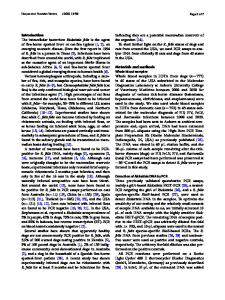First molecular identification of porcine circovirus-like agents in dogs and cats in China
- PDF / 595,227 Bytes
- 4 Pages / 595.276 x 790.866 pts Page_size
- 82 Downloads / 297 Views
SHORT REPORT
First molecular identification of porcine circovirus‑like agents in dogs and cats in China Libin Wen1,2 · Aihua Mao1,2 · Jianping Xie1,2 · Kongwang He1,2 Received: 7 July 2020 / Accepted: 12 September 2020 © Springer Science+Business Media, LLC, part of Springer Nature 2020
Abstract Porcine circovirus-like agents comprise two types of viruses: porcine circovirus-like viruses (P1, P2, P3, and P4) and porcine circovirus-like mini agents (PCVL258, PCVL264, PCVL201, and PCVL347). Of these, P1 has been identified in pigs, cattle, goats, and rabbits in China; P2, P3, P4, PCVL258, and PCVL264 have been identified in pigs; and PCVL201 and PCVL347 have been identified in cattle. The purpose of this study was to determine whether dogs and cats have been exposed to porcine circovirus-like agents. We screened 158 serum samples from diseased dogs and 41 from cats in China by PCR and nucleotide sequencing. In dogs, approximately 18% (n = 28) were positive for P1, 17% (n = 26) for PCVL258, and 9% (n = 14) for PCVL264; in cats, 17.1% (n = 7) were positive for P1, 9.8% (n = 4) for P4, and 14.6% (n = 6) for PCVL258. The P1 genomes in this study consisted of 648 nucleotides (nt) and shared 96.8 to 100% nt identity with other P1 genomes in GenBank. The P4 genome shared 98.3 to 100% nt identity with other reported P4 genomes, and PCVL258 and PCVL264 showed 100% nt identity with previously reported genomes. To our knowledge, this is the first report on molecular characterization of porcine circovirus-like agents in dogs and cats. Further studies are needed to clarify the epidemiology, evolution, and pathogenesis of porcine circovirus-like agents in dogs and cats. Keywords Porcine circovirus-like agents · Molecular identification · Dog · Cat
Introduction Porcine circoviruses (PCVs) are small, non-enveloped DNA viruses belonging to the Circoviridae family. The PCVs genomes are single-stranded circular DNA, 1700 to 2000 nucleotides (nt) long. At present, PCV can be classified into four types: PCV1, PCV2, PCV3, and PCV4. PCV1 is considered to have no pathogenicity in pigs [1], whereas PCV2 has been considered to be associated with PCV2-associated Edited by William Dundon. * Libin Wen [email protected] 1
Institute of Veterinary Medicine, Jiangsu Academy of Agricultural Sciences,·Key Laboratory of Animal Diseases, Diagnostics, and Immunology, Ministry of Agriculture, Key Laboratory of Food Quality and Safety of Jiangsu Province-State Key Laboratory Breeding Base, Nanjing, China
Jiangsu Co-Innovation Center for Prevention and Control of Important Animal Infections Diseases and Zoonoses, Yangzhou, Jiangsu, China
2
diseases (PCVAD), which cause huge economic losses to the swine industry worldwide [2]. Recently, PCV3 was identified in pigs with cardiac and multi-systemic inflammation, and in pigs with clinical signs of porcine dermatitis and nephropathy syndrome (PDNS) in the USA [3, 4]. PCV4 was recently identified in pigs with severe clinical disease in China [5]. Porcine circovirus-like agents are agents with trunc
Data Loading...











